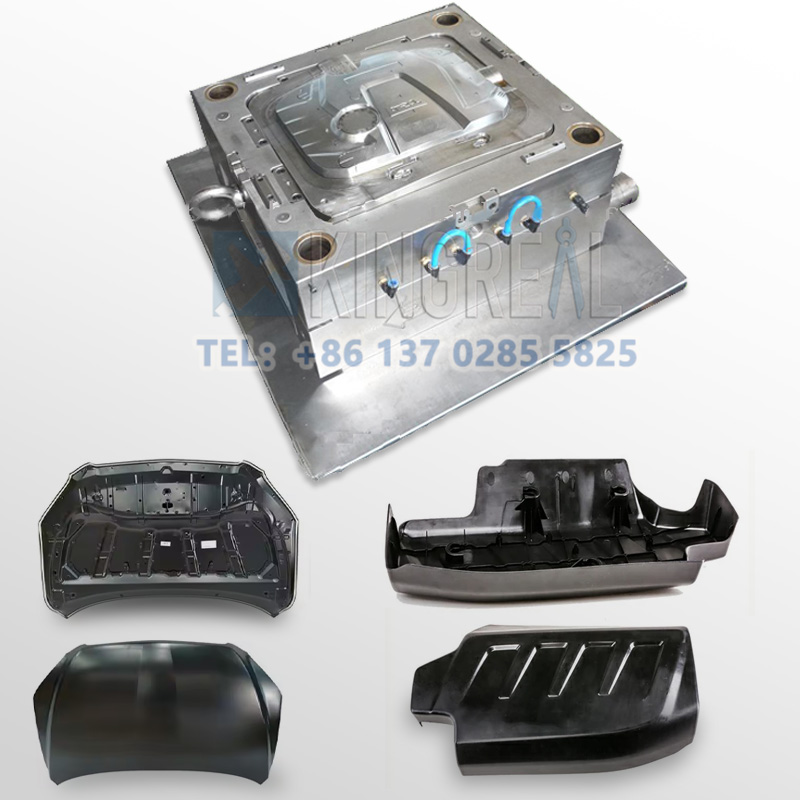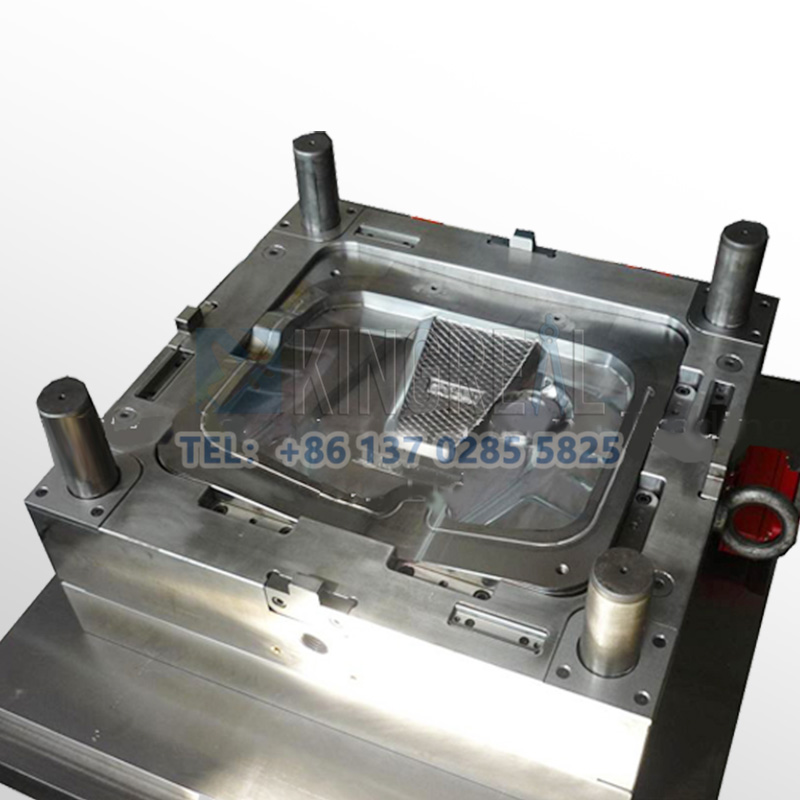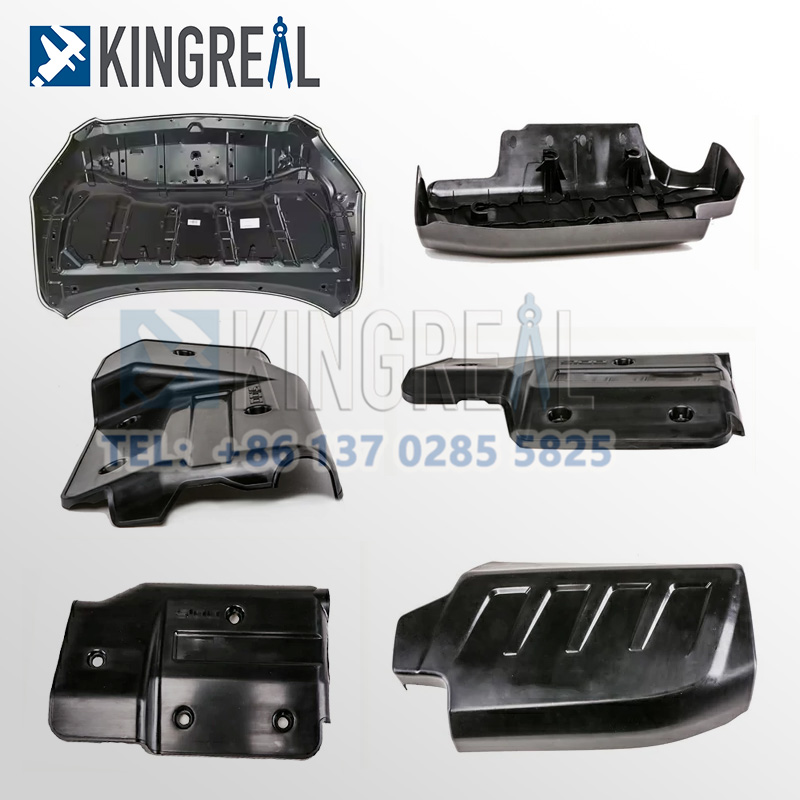
KINGREAL UNIVERSAL IND., LTD
Phone
+86-13702855825Motor cover injection molding is a processing method used in mass production of certain complex-shaped parts. The specific principle is: the heated and melted plastic raw material is pushed by the engine cover injection molding machine screw into the motor cover injection mold cavity of the plastic mold under high pressure, and after cooling and solidification, a plastic molded product is obtained.
The engine cover injection mold consists of two parts: the movable engine housing injection mold and the fixed engine housing injection mold. The movable engine cover injection mold is installed on the movable template of the motor cover injection molding machine, and the fixed engine housing injection mold is installed on the fixed template of the engine cover injection molding machine. During engine housing injection molding, the movable motor cover injection mold and the fixed motor cover injection mold are closed to form a pouring system and a cavity. When the engine housing injection mold is opened, the movable engine cover injection mold and the fixed engine housing injection mold are separated to remove the plastic product.
Although the structure of the motor cover injection mold may vary due to different types and properties of plastics, the shape and structure of plastic products, and the type of injection machine, the basic structure is the same.

| 1 | Engine Cover Injection Mold Structure by Function |
| 2 | Motor Cover Injection Molds are Divided by Structure |
1. Engine cover injection mold structure by function
Mainly composed of: pouring system, temperature control system, molding parts system, exhaust system, guide system, ejection system, etc. Among them, the pouring system and engine housing injection molding parts are the parts that are in direct contact with the plastic, and they change with the plastic and the product. They are the most complex, most variable, and require the highest processing finish and precision in the motor cover injection mold.
(1) Pouring system:
It refers to the flow channel part before the plastic enters the cavity from the nozzle, including the main channel, cold material hole, branch channel and gate, etc.
(2) Molding parts system:
It refers to the combination of various parts that constitute the shape of the product, including the movable engine housing injection mold, fixed engine cover injection mold and cavity (concave mold), core (convex mold), molding rod, etc. The core forms the inner surface of the product, and the cavity (concave mold) forms the outer surface shape of the product. After the mold is closed, the core and cavity constitute the cavity of the engine housing injection mold. According to the process and manufacturing requirements, sometimes the core and the concave mold are composed of several pieces, and sometimes they are made as a whole, and only inserts are used in parts that are easy to damage and difficult to process.
(3) Temperature control system:
In order to meet the requirements of the injection process for the motor cover injection mold temperature, a temperature control system is required to adjust the temperature of the engine housing injection mold. For motor cover injection molds for thermoplastics, the main thing is to design a cooling system to cool the engine housing injection mold (the mold can also be heated). The common method of engine cover injection mold cooling is to open a cooling water channel in the motor cover injection mold and use the circulating cooling water to take away the heat of the engine housing injection mold; in addition to using cooling water to pass hot water or hot oil, electric heating elements can also be installed inside and around the motor cover injection mold to heat the engine housing injection mold.
(4) Exhaust system:
It is set up to exhaust the air in the cavity and the gas generated by the melting of plastic during the motor cover injection molding process out of the engine housing injection mold. If the exhaust is not smooth, the surface of the product will form gas marks (gas marks), burns and other defects; the exhaust system of the engine cover injection mold is usually a groove-shaped air outlet opened in the motor cover injection mold to exhaust the original cavity air and the gas brought in by the molten material.
When the molten material is injected into the cavity, the air originally stored in the cavity and the gas brought in by the melt must be discharged to the outside of the engine cover injection mold through the exhaust port at the end of the material flow, otherwise the product will have pores, poor connection, incomplete filling, and even the accumulated air will be compressed to generate high temperature and burn the product. Generally, the exhaust hole can be set at the end of the molten material flow in the cavity or on the parting surface of the engine housing injection mold.
The latter is to open a shallow groove with a depth of 0.03-0.2mm and a width of 1.5-6mm on one side of the die. During injection, there will not be much molten material leaking out of the exhaust hole, because the molten material will cool and solidify there and block the channel. The exhaust port should not be opened facing the operator to prevent the molten material from accidentally spraying out and injuring people. In addition, the clearance between the ejector rod and the ejector hole, the clearance between the ejector block and the stripper plate and the core can also be used to exhaust.
(5) Guide system:
It is set up to ensure that the movable motor cover injection mold and the fixed engine cover injection mold can be accurately aligned when the mold is closed, and a guide component must be set in the engine housing injection mold. In the motor cover injection mold, four sets of guide pins and guide sleeves are usually used to form the guide component. Sometimes, inner and outer cones that match each other are set on the movable engine cover injection mold and the fixed engine housing injection mold to assist positioning.
(6) Ejector system:
Generally includes: ejector, front and rear ejector plates, ejector guide rod, ejector return spring, ejector plate locking screw and other parts. When the product is molded and cooled in the motor cover injection mold, the front and rear molds of the mold are separated and opened, and the ejector mechanism-the ejector pushes the plastic product and the condensed material in the runner out of the mold cavity and runner position under the push of the ejector rod of the engine housing injection molding machine, so as to carry out the next engine cover injection molding cycle.


2. Motor cover injection molds are divided by structure
Engine housing injection molds are generally composed of mold frames, mold cores, auxiliary parts, auxiliary systems, auxiliary settings, dead angle processing mechanisms and other parts according to their structure.
(1) Mold frame:
Generally, we do not need to design it, and we can order it directly from the standard mold frame manufacturer, which greatly saves the time required to design the mold, so it is called the standard mold frame of plastic molds. It constitutes the most basic frame part of the engine cover injection mold.
(2) Mold core:
The mold core part is the core part of the engine housing injection mold, and it is the most important component in the motor cover injection mold. The forming part of the plastic product is inside the mold core, and most of the processing time is spent on the mold core. However, compared with some simpler engine housing injection molds, it does not have a mold core part, and the product is formed directly on the template. Most of the early motor cover injection molds are like this, which is relatively backward.
(3) Auxiliary parts:
The commonly used auxiliary parts of engine cover injection molds are positioning rings, sprue bushings, ejectors, grab pins, support columns, ejector plate guide columns and guide sleeves, garbage nails, etc. Some of them are standard parts and can be ordered directly when ordering mold frames, and some of them need to be designed by yourself.
(4) Auxiliary system:
The auxiliary systems of engine housing injection molds are the following four: pouring system, ejection system, cooling system and exhaust system. Sometimes, because the temperature of the plastic material used needs to be heated to a very high temperature, some motor cover injection molds will also have a heating system.
(5) Auxiliary settings:
The auxiliary settings of engine cover injection molds include eyelets, KO holes (ejector holes), etc.
(6) Dead corner processing structure:
When the plastic product has a dead corner, the motor cover injection mold will also have one or more structures to handle the dead corner. Such as sliders, inclined tops, hydraulic cylinders, etc. In most domestic books, this mechanism for handling dead corners is called "core extraction mechanism".
In fact, engine cover injection molds are not difficult. No matter how the plastic product changes, for the engine housing injection mold used to form this plastic product, its structure is nothing more than the above-mentioned aspects. The difference between molds is whether the motor cover injection mold is large or small? The position or method of each auxiliary part, auxiliary setting, and auxiliary system is different. The method, structure, size, etc. of handling dead corners have changed. Of course, to make the designed mold simple to process, easy to assemble, long life, moderate price, and good molded products, design experience is particularly important. Good experience can deal with problems that arise in design and processing, and it is more confident to deal with design changes.